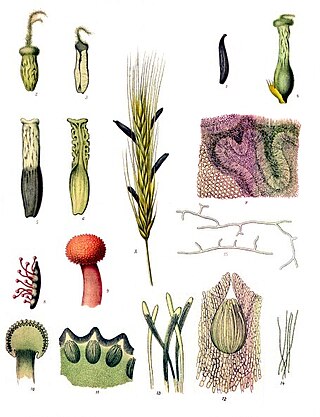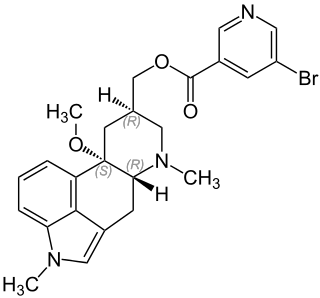
Paroxetine, sold under the brand name Paxil among others, is an antidepressant of the selective serotonin reuptake inhibitor (SSRI) class. It is used to treat major depressive disorder, obsessive-compulsive disorder, panic disorder, social anxiety disorder, post-traumatic stress disorder, generalized anxiety disorder, and premenstrual dysphoric disorder. It has also been used in the treatment of premature ejaculation and hot flashes due to menopause. It is taken orally.

Atropa bella-donna, commonly known as deadly nightshade or belladonna, is a toxic perennial herbaceous plant in the nightshade family Solanaceae, which also includes tomatoes, potatoes and aubergine (eggplant). It is native to Europe and Western Asia, including Turkey, its distribution extending from England in the west to western Ukraine and the Iranian province of Gilan in the east. It is also naturalised or introduced in some parts of Canada, North Africa and the United States.

Ergot or ergot fungi refers to a group of fungi of the genus Claviceps.

Ergotism is the effect of long-term ergot poisoning, traditionally due to the ingestion of the alkaloids produced by the Claviceps purpurea fungus—from the Latin clava "club" or clavus "nail" and -ceps for "head", i.e. the purple club-headed fungus—that infects rye and other cereals, and more recently by the action of a number of ergoline-based drugs. It is also known as ergotoxicosis, ergot poisoning, and Saint Anthony's fire.

Ergoline is a chemical compound whose structural skeleton is contained in a variety of alkaloids, referred to as ergoline derivatives or ergoline alkaloids. Ergoline alkaloids, one being ergine, were initially characterized in ergot. Some of these are implicated in the condition ergotism, which can take a convulsive form or a gangrenous form. Even so, many ergoline alkaloids have been found to be clinically useful. Annual world production of ergot alkaloids has been estimated at 5,000–8,000 kg of all ergopeptines and 10,000–15,000 kg of lysergic acid, used primarily in the manufacture of semi-synthetic derivatives.

Ergotamine, sold under the brand name Ergomar among others, is an ergopeptine and part of the ergot family of alkaloids; it is structurally and biochemically closely related to ergoline. It is structurally similar to several neurotransmitters, and it acts as a vasoconstrictor. It is used for acute migraines, sometimes with caffeine as the combination ergotamine/caffeine.
Hot flashes, also known as hot flushes, are a form of flushing, often caused by the changing hormone levels that are characteristic of menopause. They are typically experienced as a feeling of intense heat with sweating and rapid heartbeat, and may typically last from two to 30 minutes for each occurrence.

Clemastine, also known as meclastin, is a first-generation H1 histamine antagonist (antihistamine) with anticholinergic properties (drying) and sedative side effects. Like all first-generation antihistamines, it is sedating.

Butalbital is a barbiturate with an intermediate duration of action. Butalbital is often combined with other medications, such as paracetamol (acetaminophen) or aspirin, for the treatment of pain and headache. The various formulations combined with codeine are FDA-approved for the treatment of tension headaches. Butalbital has the same chemical formula as talbutal but a different structure—one that presents as 5-allyl-5-isobutylbarbituric acid.

Butabarbital is a prescription barbiturate sleep aid and anxiety medication. Butabarbital has a particularly fast onset of effects and short duration of action compared to other barbiturates, which makes it useful for certain applications such as treating severe insomnia, relieving general anxiety and relieving anxiety before surgical procedures; however it is also relatively dangerous particularly when combined with alcohol, and so is now rarely used, although it is still prescribed in some Eastern European and South American countries. Its intermediate duration of action gives butabarbital an abuse potential slightly lower than secobarbital. Butabarbital can be hydrolyzed to valnoctamide.

Dihydroergotamine (DHE), sold under the brand names D.H.E. 45 and Migranal among others, is an ergot alkaloid used to treat migraines. It is a derivative of ergotamine. It is administered as a nasal spray or injection and has an efficacy similar to that of sumatriptan. Nausea is a common side effect.

Eletriptan, sold under the brand name Relpax and used in the form of eletriptan hydrobromide, is a second-generation triptan medication intended for treatment of migraine headaches. It is used as an abortive medication, blocking a migraine attack which is already in progress. Eletriptan is marketed and manufactured by Pfizer Inc.

A dopamine agonist is a compound that activates dopamine receptors. There are two families of dopamine receptors, D1-like and D2-like. They are all G protein-coupled receptors. D1- and D5-receptors belong to the D1-like family and the D2-like family includes D2, D3 and D4 receptors. Dopamine agonists are primarily used in the treatment of the motor symptoms of Parkinson's disease, and to a lesser extent, in hyperprolactinemia and restless legs syndrome. They are also used off-label in the treatment of clinical depression. Impulse control disorders are associated with the use of dopamine agonists for whatever condition.

Tofisopam is an anxiolytic that is marketed in several European countries. Chemically, it is a 2,3-benzodiazepine. Unlike other anxiolytic benzodiazepines however, tofisopam does not have anticonvulsant, sedative, skeletal muscle relaxant, motor skill-impairing or amnestic properties. While it may not be an anticonvulsant in and of itself, it has been shown to enhance the anticonvulsant action of classical 1,4-benzodiazepines and muscimol, but not sodium valproate, carbamazepine, phenobarbital, or phenytoin. Tofisopam is indicated for the treatment of anxiety and alcohol withdrawal, and is prescribed in a dosage of 50–300 mg per day divided into three doses. Peak plasma levels are attained two hours after an oral dose. Tofisopam is not reported as causing dependence to the same extent as other benzodiazepines, but is still recommended to be prescribed for a maximum of 12 weeks.

Nicergoline, sold under the brand name Sermion among others, is an ergot derivative used to treat senile dementia and other disorders with vascular origins. Internationally it has been used for frontotemporal dementia as well as early onset in Lewy body dementia and Parkinson's dementia. It decreases vascular resistance and increases arterial blood flow in the brain, improving the utilization of oxygen and glucose by brain cells. It has similar vasoactive properties in other areas of the body, particularly the lungs. Unlike many other ergolines, such as ergotamine, nicergoline is not associated with cardiac fibrosis.

Antimigraine drugs are medications intended to reduce the effects or intensity of migraine headache. They include drugs for the treatment of acute migraine symptoms as well as drugs for the prevention of migraine attacks.
Donnatal is a combination medication that provides natural belladonna alkaloids in a specific fixed ratio combined with phenobarbital to provide peripheral anticholinergic/antispasmodic action and mild sedation. Donnatal is manufactured for Concordia Pharmaceuticals by IriSys, LLC. It is available as tablets and 5 mL elixir. Active ingredients are listed as: phenobarbital (16.2 mg), hyoscyamine sulfate (0.1037 mg), atropine sulfate (0.0194 mg), and scopolamine hydrobromide (0.0065 mg). The latter two ingredients are found in plants of the family Solanaceae, such as belladonna.

Elagolix, sold under the brand name Orilissa, is a gonadotropin-releasing hormone antagonist medication which is used in the treatment of pain associated with endometriosis in women. It is also under development for the treatment of uterine fibroids and heavy menstrual bleeding in women. The medication was under investigation for the treatment of prostate cancer and enlarged prostate in men as well, but development for these conditions was discontinued. Elagolix is taken by mouth once or twice per day. It can be taken for up to 6 to 24 months, depending on the dosage.
Antimanic drugs are psychotropic drugs that are used to treat symptoms of mania. Though there are different causes of mania, the majority is caused by bipolar disorder, therefore antimanic drugs are mostly similar to drugs treating bipolar disorder. Since 1970s, antimanic drugs have been used specifically to control the abnormal elevation of mood or mood swings during manic episodes. One purpose of antimanic drugs is to alleviate or shorten the duration of an acute mania. Another objective is to prevent further cycles of mania and maintain the improvement achieved during the acute episode. The mechanism of antimanic drugs has not yet been fully known, it is proposed that they mostly affect chemical neurotransmitters in the brain. However, the usage of antimanic drugs should be consulted with a doctor or pharmacist due to their side effects and interactions with other drugs and food.

Cholinergic blocking drugs are a group of drugs that block the action of acetylcholine (ACh), a neurotransmitter, in synapses of the cholinergic nervous system. They block acetylcholine from binding to cholinergic receptors, namely the nicotinic and muscarinic receptors.
















